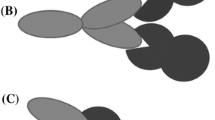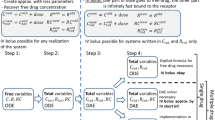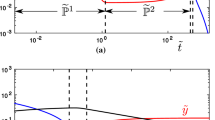Abstract
Models for drugs exhibiting target-mediated drug disposition (TMDD) play an important role in the investigation of biological products (Mager and Jusko 2001). These models are often overparameterized and difficult to converge. A simpler quasi-equilibrium (QE) approximation of the general model has been suggested (Mager and Krzyzanski 2005), but even this simpler form can be overparameterized when, for example, drug target level is not available. This work (a) introduces quasi-steady-state (QSS) and Michaelis-Menten (MM) approximations of the TMDD model, (b) derives the relationships between the parameters of the TMDD, QE, QSS and MM models, (c) investigates the parameter ranges where the simplified approximations are equivalent to the TMDD model, (d) proposes an algorithm for establishing identifiability of these models, and (e) tests this algorithm on simulated datasets. The proposed QSS approximation is more general than the QE approximation: it degenerates into the QE approximation when the internalization rate of the drug-target complex is much smaller than its dissociation rate. The proposed identifiability analysis algorithm may be applied to provide justification for use of simplified approximations, avoiding use of incorrect parameter estimates of over-parameterized TMDD models while simultaneously saving time and resources required for the pharmacokinetics analysis of drugs with TMDD. The utility of the derived approximations and of the identifiability algorithm was demonstrated on the examples of the simulated data sets. The simulation examples indicated that the QSS model may be preferable to the QE model when the internalization rate of the drug-target complex significantly exceeds its dissociation rate. The MM approximation may be adequate when the drug concentration significantly exceeds the target concentrations or when the target occupancy is close to 100%.
Similar content being viewed by others
References
Mager DE, Jusko WJ (2001) General pharmacokinetic model for drugs exhibiting target-mediated drug disposition. J Pharmacokinet Pharmacodyn 28: 507–532. doi:10.1023/A:1014414520282
Mager DE, Krzyzanski W (2005) Quasi-equilibrium pharmacokinetic model for drugs exhibiting target-mediated drug disposition. Pharm Res 22(10): 1589–1596. doi:10.1007/s11095-005-6650-0
Segel IH (1975) Enzyme kinetics. Behavior and analysis of rapid equilibrium and steady-state enzyme systems. Wiley, New York
Hayashi N, Tsukamoto Y, Sallas WM, Lowe PJ (2007) A mechanism-based binding model for the population pharmacokinetics and pharmacodynamics of omalizumab. Br J Clin Pharmacol 63(5): 548–561. doi:10.1111/j.1365-2125.2006.02803.x
Beal SL, Sheiner LB, Boeckmann AJ (eds) (1989–2007) NONMEM users guides. Icon Development Solutions, Ellicott City
Nonmem VI®, NONMEM Project Group. University of California at San Francisco, San Francisco
Author information
Authors and Affiliations
Corresponding author
Rights and permissions
About this article
Cite this article
Gibiansky, L., Gibiansky, E., Kakkar, T. et al. Approximations of the target-mediated drug disposition model and identifiability of model parameters. J Pharmacokinet Pharmacodyn 35, 573–591 (2008). https://doi.org/10.1007/s10928-008-9102-8
Received:
Accepted:
Published:
Issue Date:
DOI: https://doi.org/10.1007/s10928-008-9102-8




